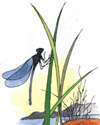
<
WELCOME TO THE WONDERFUL LAND OF
DRAGONFLIES AND DAMSELFLIES !
India.
As everybody knows, Dragonflies are one of the most beautiful creatures in the earth, and fortunately, about more than 500 species , including an endangered species Epiophlebia laidlawi, ( 286 dragonflies and 214 Damselflies) are found in India out of 5500 around the world. Furthermore, 115 are endemic to our country. They are closely associated with Indian culture, folklore and literature. And this is the first web site on Indian Odonata.
India shows great diversity in all fields, such as Culture, Language, Social customs and in Geography. In the case of Biodiversity, India is one among the seventeen Megadiversity countries of the world, due to its geographical peculiarities . The northern region is guarded by the Great Himalayas and the southern side is surrounded by the oceans. This richness in biological diversity is evident in the Indian Odonata group too. My native place , Kerala , one of the small states of India, lies at the extreme south western tip of this country. The eastern side of Kerala,(" God's own country") is protected by the Western Ghats ( a chain of mountains with tropical rain forest, now it has been considered as one of the " hot spots" of the world regarding the biodiversity.) and the western side with the Arabian sea. Fortunately , we are getting a good quantity of rain fall ,approximately 3000 mm per year due to the South west monsoon ( June to August ) and South east monsoon ( September to November). Because of the high rain fall, we have 44 rivers and out of which ,41 flowing from Western Ghats to western side and join to Arabian sea and three are flowing to eastern side and end in Bay of Bengal. Geographically, Kerala is an ideal place for Dragonflies and Damselflies in tropical region with a lot of aquatic ecosystems for their existence in our country.
Our spring season comes in September after the heavy monsoon rain( June- August) and we can see everywhere the carnival of all types of lives including Dragonflies and Damselflies. Surprisingly, the Pantala flavescens is the first emerging species and seen in large groups, may be migrated from other places.
In my mother tongue, Malayalam, generally Dragonflies are called "Thumbikal". If we see these at the season of "Onam"( a paddy harvest festival in the month of August) we call them as "Onathumbikal"(Pantala flavescens) and Gomphids are called "Kallanthumbikal"( Kallu means stone!, these are capable of carrying small stones by their legs and children love to prompt these flies to take the stones)
If we watch these organisms very closely, we can see highly interesting behaviour patterns in feeding and reproduction .After the harvest of the paddy, the Pantala flavescens are seen as a flock around the hay stacks searching for the preys . I have observed here , libellulids flying inside the houses with marble or mosaic floors which have very good reflection like water, and laying eggs , mistaking the same as ponds and pools.
The local people in the forest area use a special Dragonfly net to catch these flies cleverly. The net is made and used in a very simple way . A long twig is cut ,the apical end is made round or oval in shape and tied tightly. The rounded or oval part is twisted in the spider web( which is easily available in the forest area , of the Giant spider) two or three times until it is covered by the web as a thin film. Then the same is placed on the body of the Dragonfly /Damselfly carefully. Immediately , the insect tries to fly , but it is entangled in the spider web and we can catch the same very easily. I tried the same method to catch Neurobasis chinensis, and in the first attempt itself I succeeded. So if anybody forgets to take the real dragonfly net to the forest, do not worry, please try this method .
I have collected more than 70 species of this group from this region,( Kerala and Western Ghats) and managed to take photographs of many of these enchanting organisms. I do hope that more species of this group are available from this small province within a very short period.